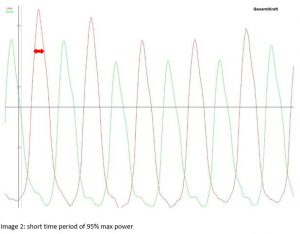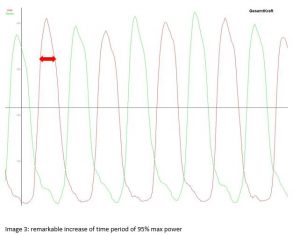How to adress pedalling efficiency due squat exercises in cycling
In bike fitting, the adjustment of the rider’s position as well as the choice of components is made according to his/her individual goals and athletic condition. In a nutshell: the bike is adjusted to the rider, not the other way round.
However, a well-trained fitter keeps in mind the second component as well that leads to a perfect symbiosis of equipment and athlete: working on the rider him-/herself. Of course, you’ll first adjust the bike to the rider, but in mid-term you’ll only get to the desired and most efficient position, if certain adjustment processes are also triggered on the athlete.
As cycling does not train the rider’s body in a balanced way, the body may and must be influenced. It will, e.g., only be possible to maintain a stable position while pedaling powerfully, if the rider’s core is strong.
Therefore, improving a rider’s flexibility and his/her movement control is a component of professional optimization of the position on the bike – just like manual manipulation by a therapist in case of decompensated physical conditions. Or put simply: athletic training to improve flexibility and movement control as well as manual therapy at a physiotherapist’s if needed.
Hardly any rider has not yet read about the value of squats in this context. In this blog article I’ll examine certain cycling-specific aspects of the squat as a specific training measure for cyclist.
The squat as training measure: how to address individual pedaling pattern?
There are books dealing with just one exercise by itself: the squat – and they exist for a reason. Appearing very simple at first glance, several ways of conducting a squat and faulty performance suddenly make it seem a very complicated exercise. As it is the case with any athletic exercise also squats have to be taught and performed correctly. Otherwise you’ll may lack efficiency or in worst case you’ll hurt yourself.
“The Squat Bible: The Ultimate Guide to Mastering the Squat and Finding Your True Strength” from Dr Horschig/Sonthana is one of various books at the market which gives a detailed insight in the practical strategy of proper squatting and absolutely worth reading.
Furthermore it is highly recommended that a bike fitter who does not have physiotherapeutic or sports science expertise work together with an expert in order to be absolutely sure when it comes to instruction, conducting and judging.
It is our goal in cycling analysis to improve cycling performance by means of effective training measures. But what does this look like in everyday life and how do we address the rider´s individual pedaling pattern?
The study “Joint Angle Specific Strength Adaptations Influence Improvements in Power in Highly Trained Athletes” by Rhea et al (2016) proves the influence of the depth of a squat when performing it.
As cyclists optimally use a relevant part of their power at a very early point of the pedaling movement (at 80° of knee joint), develop maximum power at a knee joint angle of 110 to 130° and power transfer is sound until the bottom dead center is reached (knee joint angle of 136 to 140°), squat performance should include 80 to 145° knee joint angle. This is equivalent to the so called deep or full squat that has been preferred in training science so far.
By specifically analyzing the pedaling power in the lab, it can be precisely determined with the aid of power diagrams in which phase of the pedaling movement there is room for optimization. Proposal: If there is a lack of power in the downward phase, training programs will focus on deep squats. If power is lacking in the low front quadrant, the program could focus on quarter squats.
Case study
Rider: ambitious rider, has been performing squats in athletic training for > 1 year and attains 1.5 times his body weight (1 rm = repetition max).
What strikes when looking at the pedal stroke analysis before winter training is that the rider reach an early power peak at a crank position of 85 / 90° in the pedal stroke. The visualization of the force – time plots in image 2 helps to understand the unfavourable effect on the applied force: the time period when 95% of max force, we call it “plateau”, is with a mean value of 7msec very short. Literally the rider pushes hard in the pedal but not necessarily effective.
Training program during off-season
- Wave-like periodisation for 12 weeks, 4 sessions / week
- 2x tough workout: ¼ squats (60-80°) 4-8 sets with 8 repetitions at maximum intensity
- 2x easy workout: step-ups, lunges, full squats (< 110°) 2 sets respectively, with own bodyweight and full movement execution
Check-up after 12 weeks
Performing the same protocol after a training period of 12 weeks the follow up measurement is performed to evaluate the effect of the training on cyclist´s pedaling.
In this example case the time period of effective force application increased by over 30%. The force-time-plot visualizes the improved pedaling movement due to which 95% of maximum power now start early and can be retained for a relevant longer time. An increase of “plateau” – length can be interpreted as increase in efficiency as this way of pedaling requires less peak power with every single stroke in order to generate the same power. In an endurance sport like cycling this in turn leads to more effective power delivery and slower fatigue. In this case the training can be perceived as successful.
It need to be taken in account that there are various influencing aspects on pedaling strategies like the ongoing field and athletic training which additionally result in various human adaptations.
Nevertheless, we´ve experienced measurable influences on pedaling pattern out of three key strategies:
- Optimization of the setup of the bike: seat height! Saddle fore aft!
- Training with decoupled cranks
- Individual squat training as described
Conclusion
For cyclists squats may be an effective training measure on solid ground. Individual, rider-specific choice of exercise performance and planning of training should be made conscientiously in order to achieve the desired success.
We´re keen to transfer scientific approaches and findings into practice and appreciate sharing these, furthermore all comments are very welcome.
There are two publications in the upcoming time which I´d like to highlight:
English: Cheung / Zabala: “Cycling Science”
http://www.humankinetics.com/products/all-products/cycling-science
(Also available via Amazon)
German: Sandig / Schlömmer “Programmdesign im Functional Training”
https://www.m-vg.de/riva/shop/article/3794-programmdesign-im-functional-training/





